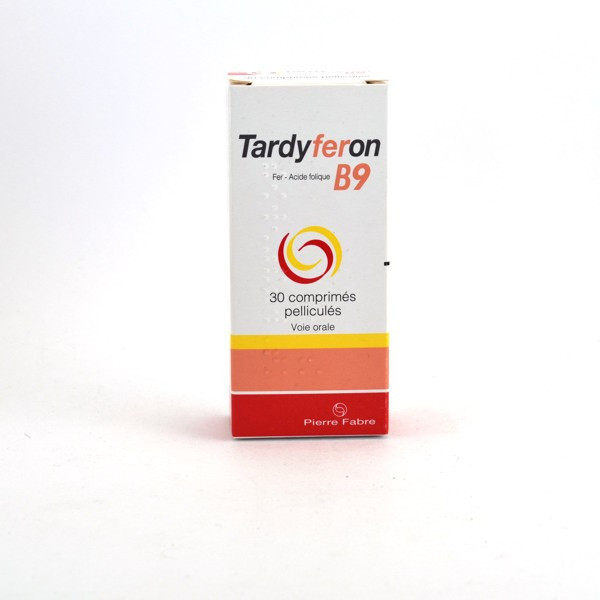1. NAME OF DRUG TARDYFERON B9, coated tablet. Iron: 50.0000 mg Under the form of ferrous sulphate: 154.530 mg Flic acid (anhydrous): 0.3500 mg Per coated tablet. To see a complete list of dilutants, see section 6.1. 3. PHARMACEUTICAL FORM Coated tablet. 4. CLINICAL DATA 4.1 Therapeutical indications Preventative treatment for iron and folic acid deficiency during pregnancy when food intake is not enough. Should not be used in the primary prevention of the risk of embryonic anomalies of neural tube closure (AFTN: spina bifida ...). 4.2 Dosage and how to use 1 tablet per day, 50mg of iron and 350ug of folic acid during the last two trimesters of pregnancy (from the 4th month). Swallow the tablet whole. Do not suck, chew or keep the tablet in your mouth. Take with a large glass of water before meals. The time of dose depends on your digestive tolerance. 4.3 Contraindications - iron excess - allergy to one of its components 4.4 Special warnings and precautions of use Cautions: Due to the risk of dental colouration and oral ulceration, tablets should not be sucked, chewed or kept in the mouth but should be swallowed whole with a large glass of water. Precautions for use Tea consumption inhibits iron absorption. 4.5 Interactions with other drugs Combinations to avoid: + Iron (salts) (injectable) Lipothymia, or even shock attributed to the rapid release of iron from its complex form and saturation of siderophilin. Combinations to be aware of - The iron ions inhibit the resorption of cyclines when taken orally Take iron salts at a different time to cyclines (for example 2 hours). - Increased risk of D-penicillamine toxicity when ferrous treatment is stopped. - Absorption of iron can be decreased if simultaenous treatment of gastric dressing. Take anti-acids at a different time to iron salts (for example 2 hours). 4.6 Pregnancy and breast feeding Pregnancy: Negative clinical data on a few thousand treated women seem to exclude a detrimental effect of ferrous sulphate. Under normal conditions this medication can be prescribed during pregnancy. Breast feeding: The passage of ferrous sulphate in breast milk has not been evaluated, but given the nature of the molecule, it is possible to administer this drug in breastfeeding women. 4.7 Effects on the ability to drive and operate machinery Not applicable. 4.8 Side effects The table below shows the side effects observed in 7 clinical studies, accounting for a total of 1051 patients, including 649 patients under Tardyferon, for whom the causal link can not be excluded with the product. Side effects are listed according to the MedDRA organ system classification and listed below as: very common (³ 1/10), common (³ 1/100,



